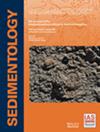自生和异体对浊积岩瓣叠置模式和构型的控制:以挪威中部近海Dønna台地的Turonian - Coniacian深水浊积岩瓣杂岩为例
IF 2.8
2区 地球科学
Q1 GEOLOGY
引用次数: 0
摘要
控制深水浊积叶堆积模式的机制目前有广泛的解释。利用大型沉积物岩心、测井和地震数据,对Marulk大地区(挪威海Dønna台地)的Turonian - Coniacian浊积岩叶状复合体进行了研究,以检验各种控制因素的平衡和各自的影响。基于对白垩纪三个浊积岩叶状体系的详细沉积学研究,描述了一个四层叶状体系,涉及多种沉积过程和流态。由此推断的沉积叠置模式被用于识别浊积叶大尺度沉积构型上的自生和异生强迫。自生过程(在岩心数据中观察得最好)控制着沉积物扩散的自我调节和叶状亚环境的广泛演化。相反,异源强迫(在测井资料中观察得最好)调节浊积叶演替中的轴向迁移,控制沉积脉冲,最终控制浊积叶复合体的总体演化趋势。除此之外,本文还提出了一种新的方法,旨在解释封闭和非封闭浊积岩叶状体沉积中不同层次上的自生-显性和异体-显性过程,这可能有助于为地质模型分配适当的输入,从而更好地理解叶状体沉积结构的内部和外部控制。有人主张,这种方法最终可能用于其他沉积体系,例如来自沿海环境的三角洲复合体,无论是在实际的还是古代的沉积物中。本文章由计算机程序翻译,如有差异,请以英文原文为准。
Autogenic and allogenic controls on turbidite lobe stacking pattern and architecture: The case of the Turonian to Coniacian deep‐water turbidite lobe complexes (Dønna Terrace, offshore Mid‐Norway )
ABSTRACT The mechanisms controlling the stacking patterns of deep‐water turbidite lobes are currently open to a wide range of interpretations. A study of Turonian to Coniacian turbidite lobe complexes in the greater Marulk area (Dønna Terrace, Norwegian Sea) was undertaken to examine the balance and respective influences of various controlling factors using a large sediment core, well‐log and seismic dataset. A four‐tiered lobe hierarchy is described based on a detailed sedimentological study of three Cretaceous turbidite lobe systems, involving a variety of sedimentary processes and flow regimes. The inferred depositional stacking patterns were then used to identify autogenic and allogenic forcings on the large‐scale depositional architecture of turbidite lobes. Autogenic processes (best observed in core data) control the self‐regulation of sediment dispersal and the broad evolution of lobe sub‐environments. Conversely, allogenic forcings (best observed in well‐log data) regulate axial migration within the turbidite lobe succession, and control sediment pulses and ultimately the general evolutionary trend of the turbidite lobe complex. Beyond this, an updated approach is proposed here aiming at deciphering autogenic‐dominant and allogenic‐dominant processes at different hierarchical levels in both confined and unconfined turbidite lobe deposits, which may help with assigning appropriate inputs for geomodels for an improved understanding of the internal and external controls on lobe depositional architecture. It is advocated that this approach may eventually be used in other depositional systems, such as in deltaic complexes from coastal settings, both in actual and ancient sediments.
求助全文
通过发布文献求助,成功后即可免费获取论文全文。
去求助
来源期刊

Sedimentology
地学-地质学
CiteScore
8.20
自引率
11.40%
发文量
94
审稿时长
6-12 weeks
期刊介绍:
The international leader in its field, Sedimentology publishes ground-breaking research from across the spectrum of sedimentology, sedimentary geology and sedimentary geochemistry.
Areas covered include: experimental and theoretical grain transport; sediment fluxes; modern and ancient sedimentary environments; sequence stratigraphy sediment-organism interaction; palaeosoils; diagenesis; stable isotope geochemistry; environmental sedimentology
 求助内容:
求助内容: 应助结果提醒方式:
应助结果提醒方式:


